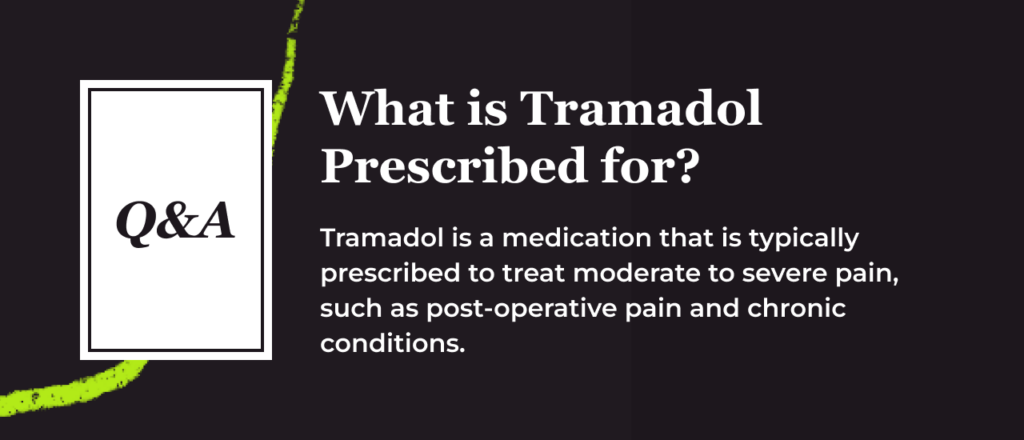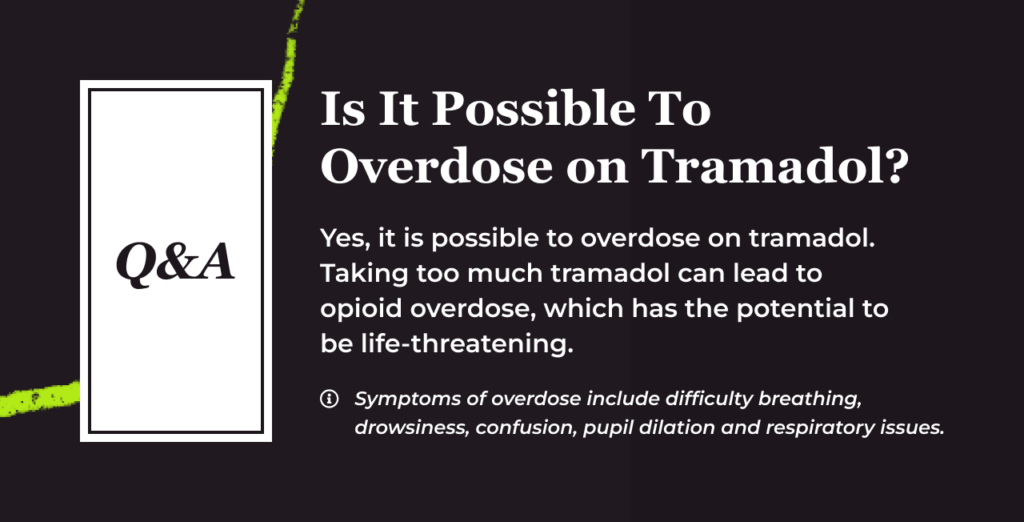Tramadol is a prescription painkiller with unique chemical properties. While some people may believe tramadol is safer than other painkillers, it can cause misuse problems, and this can lead to addiction.
Tramadol is a weak opioid agonist, and it’s closely related to drugs like Vicodin and OxyContin.[1] Doses spark the release of chemicals like dopamine, causing euphoria and a feeling of well-being.
Some people start using tramadol to ease pain, but they progress to misusing the drug for its euphoric properties. In time, they use tramadol to keep withdrawal symptoms and discomfort at bay.
Tramadol’s withdrawal symptoms make quitting difficult, but treatment programs can help. With medications and therapy, you can stop using the drug and develop a healthier life.

How Addictive Is Tramadol?
All medications within the opioid class can cause chemical changes leading to addiction. Tramadol, like all opioids, can cause this process, even in people who never considered themselves drug users.
When compared to other opioids, tramadol is weaker. It comes on slower, and in studies, people rarely identify it as an opioid unless it is administered in large doses.[2] They may recognize that the drug triggers euphoria, but they may not think it’s as powerful as something like Vicodin.
Meanwhile, tramadol works within the brain much like other opioids do. It triggers the release of neurotransmitters like dopamine, causing a feeling of calm and well-being. While people might begin taking the drug for pain, they may keep taking it for euphoria or withdrawal management.
Researchers say 1.5% of people misuse tramadol compared to 6% misusing hydrocodone.[3] Statistics like this demonstrate that tramadol has a smaller risk profile than other prescription painkillers. But it can be — and often is — misused.
Studies suggest that people who have never used an opioid before are at higher risk of tramadol misuse.[2] People with a long history of opioid use disorder (OUD) may not feel that tramadol is strong enough. But people who have never taken such drugs may experience euphoria with their first dose, and they may spend the rest of their lives chasing that high.

What Does Tramadol Misuse Look Like?
People who misuse tramadol don’t fit into neat categories. Anyone who takes strong drugs could develop a physical or psychological attachment to them. Often, an addiction develops so slowly and quietly that people don’t notice the problem until it’s too late.
Physical symptoms of tramadol misuse include the following:
- Unexplained sedation
- Frequent complaints of pain (used to obtain more drugs)
- Weight loss
- Disheveled appearance
Behavioral symptoms of tramadol misuse include the following:
- Increased need for privacy
- Frequent visits to doctors for refills
- New friends or acquaintances
- Loss of interest in things the person once enjoyed
- Poor performance at work or school
Some people who misuse tramadol are adept at hiding their drug use, and they may struggle in private for years. Handling the misuse isn’t a sign of strength. Without help, the OUD will deepen, and the damage it inflicts will grow.
How Dangerous Is Tramadol?
Like all prescription medications, tramadol causes specific risks. For people in pain, the benefits tend to outweigh the risks. But those dangers don’t go away, and people who are misusing the drug may not understand the physical problems they might face.
General dangers associated with tramadol include the following:[4]
- Seizure risks
- Suicide risks
- Serotonin syndrome (with symptoms like agitation, hallucinations, low body temperature, incoordination and gastrointestinal distress)
Two more problems may appear in people with OUD triggered by tramadol.
Withdrawal Syndrome
Brain cells accustomed to tramadol malfunction when the drug is abruptly discontinued. Many people experience a familiar opioid withdrawal syndrome characterized by the following symptoms:[4]
- Anxiety
- Insomnia
- Muscle pain
- Digestive distress
- Goosebumps
Some people experience hallucinations or severe aggression while withdrawing from tramadol, which is a symptom not often seen in those who misuse other opioids.
Drug withdrawal is both painful and frightening. Some people relapse to drugs to remain comfortable and safe. If they relapse to their accustomed dose, they may overdose. Brain cells heal and down-regulate during sobriety, so a once-safe amount could be far too much a day or two later.

Overdose
Tramadol is a central nervous system depressant. Take too much, and you could overwhelm your body and experience a life-threatening emergency.
Tramadol overdose symptoms include the following:[4]
- Sedation
- Slow breathing
- Poor responsiveness
Some people experience seizures due to tramadol overdoses.[5] This symptom isn’t common with other opioids (like Vicodin), but it’s a documented problem with tramadol.
As people take larger and larger tramadol doses to get high, they come closer to toxic amounts. Overdose is also much more likely if someone combines use of tramadol with other substances like alcohol.
Similarly to other opioids, tramadol that is bought on the street may be laced with other substances like fentanyl. A user might not know this, and overdose can quickly occur.
Someone with an OUD may overdose multiple times until they finally get the treatment they need.
MAT for Tramadol Misuse
Tramadol is an opioid, meaning that anyone who uses Tramadol repeatedly can develop an OUD–but fortunately, this can be treated with Medication for Addiction Treatment (MAT) programs.[6] Providers use prescriptions like Suboxone to amend chemical imbalances caused by opioids, allowing people to quit the drug without uncomfortable withdrawal.[7] Those same medications can ease cravings for tramadol, allowing people to handle their triggers without relapse.
Some people stay enrolled in MAT programs indefinitely. The medications are safe and effective for long-term use. As long as the risk of relapse exists, the medications can help.
Bicycle Health, a leading telemedicine MAT provider, makes treatment convenient and private. Conduct appointments via phone or computer from home, and pick up your prescription at a pharmacy you choose. Contact us to find out if this model is right for you.

Reviewed By Peter Manza, PhD
Peter Manza, PhD received his BA in Psychology and Biology from the University of Rochester and his PhD in Integrative Neuroscience at Stony Brook University. He is currently working as a research scientist in Washington, DC. His research focuses on the role ... Read More
- "With Tramadol, I Ride Like a Jaguar:" A Qualitative Study of Motivations for Non-Medical Purpose Tramadol Use Among Commercial Vehicle Operators in Kumasi, Ghana. Substance Abuse Treatment, Prevention, and Policy. https://substanceabusepolicy.biomedcentral.com/articles/10.1186/s13011-020-00292-4. July 2020. Accessed April 2023.
- A Systematic Review of Laboratory Evidence for the Abuse Potential of Tramadol in Humans. Frontiers in Psychiatry. https://www.ncbi.nlm.nih.gov/pmc/articles/PMC6775208/. September 2019. Accessed April 2023.
- Misuse of Tramadol in the United States: An Analysis of the National Survey of Drug Use and Health 2022-2017. Substance Abuse: Research and Treatment. https://journals.sagepub.com/doi/10.1177/1178221820930006. June 2020. Accessed April 2023.
- Tramadol Prescribing Information. U.S. Food and Drug Administration. https://www.accessdata.fda.gov/drugsatfda_docs/label/2010/022370s000lbl.pdf. May 2010. Accessed April 2023.
- Tramadol Overdose Causes Seizures and Respiratory Depression but Serotonin Toxicity Appears Unlikely. Clinical Toxicology. https://pubmed.ncbi.nlm.nih.gov/25901965/. July 2015. Accessed April 2023.
- Effects of Medication-Assisted Treatment (MAT) for Opioid Use Disorder on Functional Outcomes: A Systematic Review. Rand Health Quarterly. https://www.ncbi.nlm.nih.gov/pmc/articles/PMC7302321/. June 2020. Accessed April 2023.
- Suboxone: Rationale, Science, Misconceptions. The Ochsner Journal. https://www.ncbi.nlm.nih.gov/pmc/articles/PMC5855417/. Spring 2018. Accessed April 2023.
Download Our Free Program Guide
Learn about our program, its effectiveness and what to expect
Imagine what’s possible on the other side of opioid use disorder.
Our science-backed approach boasts 95% of patients reporting no withdrawal symptoms at 7 days. We can help you achieve easier days and a happier future.